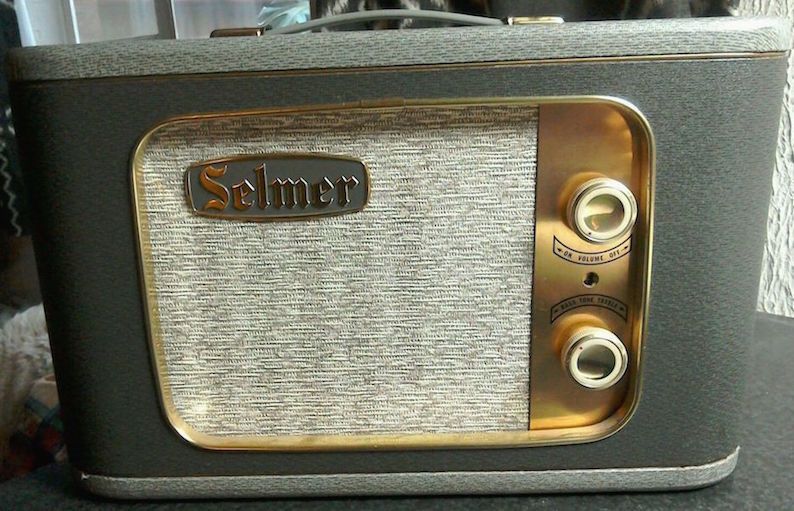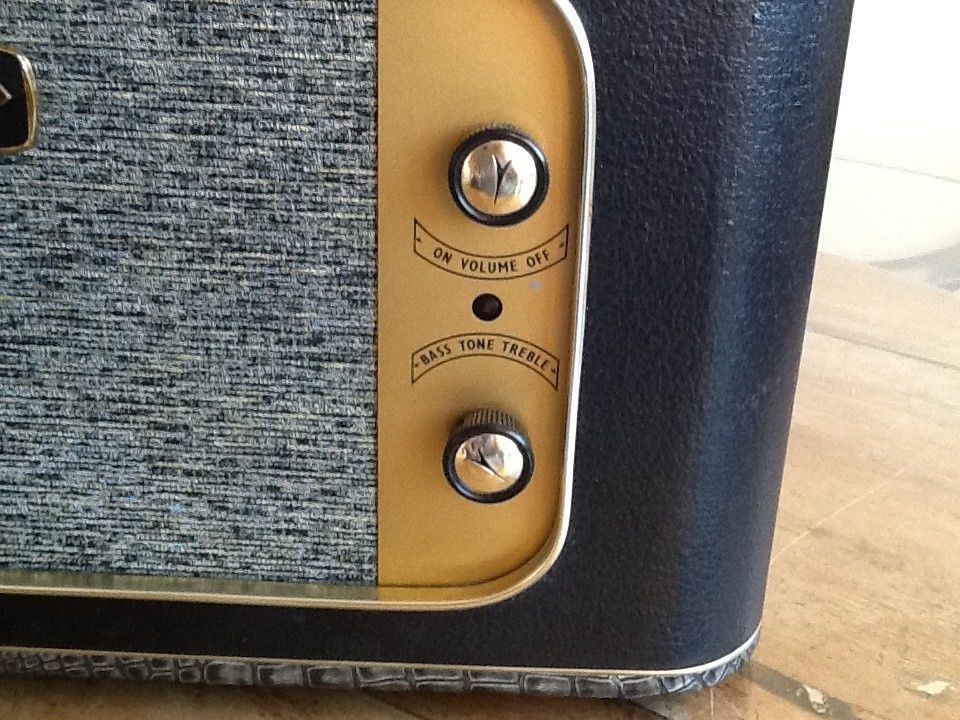Little Giants...
...on the shoulders of Dwarfs.
In the search for perfect tone it’s sometimes easy to feel that we are merely “dwarfs standing on the shoulders of giants”. The greats of yesteryear showed us the way when electric guitars were young
— and we still want to emulate those timbres. In that fashion many of us have favoured, over the last decade or so, the bespoke low-wattage recording amp. But long before the boutique amp phenomenon, there were tiny terrors of tone that allowed aspiring guitarists to go electric without tormenting the neighbours. Extrapolations of the radio and other home audio amplifiers that guitarists had started to bastardize for themselves, these early British guitar amps would often look like sideboard wireless sets and were constructed in much the same way. The early versions of Charlie Watkins’ Clubman & Westminster amps of the fifties and early sixties are prime examples of these stylish amps. Of course being low output devices these compact combos would start to distort when the volume knob was really cranked; and that tone became an end in itself
—
one that guitarists in the late sixties tried to replicate on stage with bigger boxes. But those early, entry-level models are exactly what the producer ordered when it comes to fat overdrive in the control room. If you’re after hot tone and creamy distortion in the studio why take hours to audition a bunch of stomp boxes when you can use a small, vintage, valve amp that will respond to your playing more dynamically than any pedal? For my money the most stylish of those student model amps, both in sight and sound, is the Selmer Little Giant; and of the four styles it came in ("Blood & Custard", "Blue & Grey", "Silver Croc-skin" and "Black & Blue"), over the period of it's manufacture between 1958 and 1970, my favourite is the Mk.II “Blue & Grey” livery (from 1961-63). That’s why I bought one; it’s serial number is 5448 and there's a picture of it below. It looks good, but it sounds even better. (We recently added a 1963-65 era Croc-skin Little Giant #14845 to our amplifier armoury as well! 13/3/18)
Of course it sounds oxymoronic at first but the name is apt indeed — this little box simply has a giant voice. If you’re lucky enough to own a Little Giant you’ll be nodding wisely as you read this — just ask Keith Richards. In his autobiography Life , Richards talked about his first dedicated guitar amp thus: "I was always soldering and rewiring behind the amp — a Little Giant amp the size of a radio. I was one of the first to get an amp. We were all using tape recorders before that. Dick Taylor used to plug into his sister's Bush record player. My first amp was a radio; I just took that apart. My mother was pissed off. The radio's not working because I've got it apart and I'm plugging, zzzz, just trying to get a sound. In that respect good training for later on — honing your sound, matching guitars to amps."

Surely Keef was winding us up with talk of Dick plugging into Bush, but when it came to winding up the volume, choices were definitely limited for budding rock stars at the dawn of the 60s. Rory Gallagher is reported to have said "I had a Selmer Little Giant 4-watt amplifier, too, which I would really love to have now for a practice amp.”* Indeed, in an interview from the February 1985 issue of Guitarist magazine Rory stated “My very first guitar was a Rosetti Solid Seven — I think it was Italian** — they made the Lucky Seven as well. It was pretty good. I used a Selmer Little Giant amp, but I got rid of it because it was distorting! If I had it now I’d be delighted!” Gallagher and Richards certainly weren’t the only advocates of Selmer’s tiny titan who genuinely relished it’s rich distortion — it’s fantastic harmonic overtones when pushed to the limit. In an interview with Robin Trower first featured in the April 1974 issue of Guitar Player , he spoke about his Little Giant and how he tried to continue using it as a performance tool on stage (you can find the interview in full at effectrode.com): “It’s difficult to pin down when I started to get into distortion, but it was definitely before my Procol Harum days. I used to play through a Selmer Little Giant valve amp which had one tiny speaker in it, and I ran a jack lead off the speaker points into a small Fender. That way, I got some of the hardness above it from the Fender and all my distortion sort of smoothness from overloading the Selmer. But, unfortunately, when it came to playing bigger places needing a bigger sound, I tried running the Selmer through a Marshall, and it didn’t work. When you start to wind up the wick a bit it used to start whistling; therefore, I had to break down and start all over again to get the sound I liked. But on songs like Repent Walpurgis (the last track on September 1967’s eponymous debut album Procol Harum ), that’s the Little Giant with the Fender, and I used my Chet Atkins solid-body.” There were probably many other famous musicians whose heartbeats & backbeats first quickened to the electric thrill of this classic compact combo. When recounting the purchase of his first Fender Jazz Bass in his autobiography The Living Years Mike Rutherford wrote “I also ended up with a Selmer Little Giant amp — impressive name, teeny little thing… Even to me the sound seemed loud — beautifully loud.” ***
So what Selmer sorcery was summoning these sacred sounds? Well, nothing out of the ordinary for the time, really. With AC/DC rectification being handled by an EZ80 and the signal ramped up through single ECC83 & EL84 pre-amp & power stages, that were finally pushed into the air by a single six inch Elac speaker, this all-valve baby-box Selmer was very similar to it’s contemporary, the Vox AC-2 (later renamed the AC-4, presumably to imply the wattage). It weighed about 4.3 kg or 9 lb 7½ oz (9.471 lb) in a box that was 15.4 x 10.2 x 5.5 inches, or 390 x 260 x 140 mm, small. The Vintage Hofner website rather succinctly describes the SLG like this: “Could easily be mistaken for a little radio, producing a mighty 4 watts (or 8 watts US, where they used peak output rating) via it's ECC83 (1), EL84 (1) and EZ80 (1) valves and tiny speaker. Size 15½" x 5½" x 9", front-mounted control panel with 2 knobs (volume, tone) and a pilot light. All for 11 guineas (a guinea being one pound and one shilling, it had stopped being legal tender decades earlier but it was still considered "posh" to quote prices in guineas).” By the time my #5448 was in the shops the price had gone up to 12 guineas but it was still a lot easier to get hold of in 1962 Britain than a Fender Champ.
But why not come down to New Cut Studios with your favourite guitar and hear for yourself? And if you think you’re going to need 25% more power than a Little Giant, well then we have a dynamite little 5w amp: our 1965 Blackface Fender Vibro~Champ. TOO LOUD? We also have one of Zachary Vex’s tiny half-watt tube amps — check out this giant little raunch rocket. The Zvex Nano Head can quite happily drive any of our 4x12” cabinets and is powered by two JAN 6021W military spec valves — Philips ECG’s USA made “Joint Army Navy” special quality version of the ECC70. These sub-miniature dual triode tubes were designed to withstand the extreme conditions they would encounter in the guidance systems of ballistic missiles. You see, sometimes it is rocket science.
* Rory Gallagher actually used a Ross Fame Series Model 10 Tube Blaster as a dressing room amp. It was a solid state, 25w 1x8" combo, with an overdrive circuit switchable from the front panel or via a footswitch jack on the rear panel. This "Tube Blaster" switch engages a built-in distortion based on JRC4558 op-amp chips. Sound familiar? Surely the company from Chanute, KS famous for the much cloned "Grey Compressor" pedal wouldn't copy an overdrive circuit from Ibanez? Well, whilst they don't have any tubes to scream in their power stage, these little amps sound so great we got four of 'em! Of course the reason they sound great is that Bud Ross' company also built the highly acclaimed solid state Kustom amps in the '60s & '70s.
** Rosetti were of course an English company established in the 1920s but the Solid 7 was built for them by the Dutch company Egmond. If you’ve seen pictures of Paul McCartney playing his in Hamburg you’ll know it looks something like a Yamaha SG with a trapeze tailpiece and a Supro headstock — although Egmond built several variants with this name.
*** Rutherford was a real champion of British gear with his long term use of Shergold guitars & basses, but he also continued to use small British made amps throughout a long and successful career with Genesis and Mike & The Mechanics, owning no fewer than seven Sessionette:75 1x12" combos! We have a very fine original 1984 Axess-Session model of this little 75 watt "British Boogie" here at New Cut and it's our benchmark for solid state amps.


